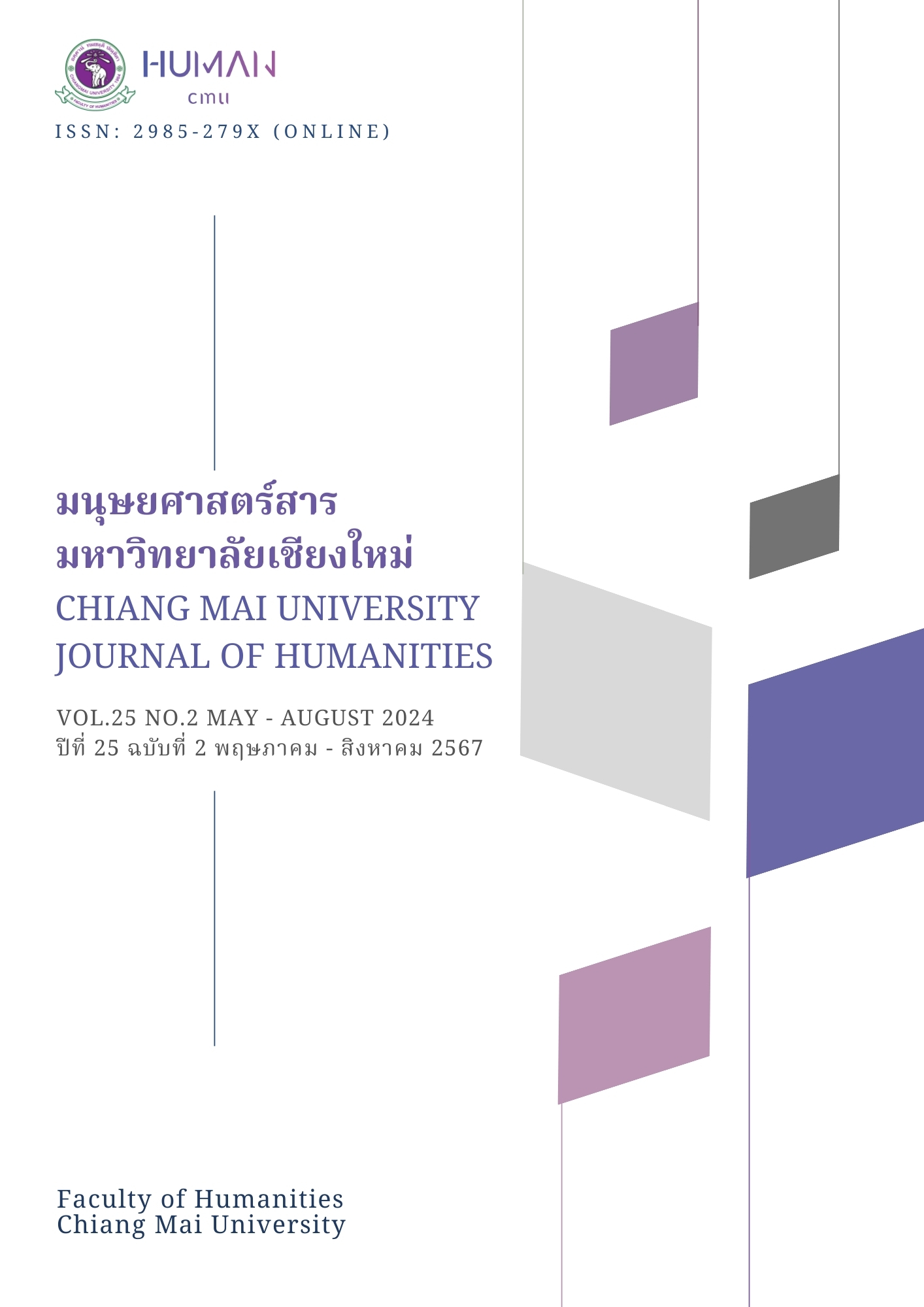สถานะของการจัดการความรู้เพื่อสืบสานและอนุรักษ์ศิลปหัตถกรรมท้องถิ่น กรณีศึกษา เรือกอและจำลอง ในเขตพื้นที่ชุมชนศิลปาชีพในสมเด็จพระนางเจ้าสิริกิติ์ พระบรมราชินีนาถ พระบรมราชชนนีพันปีหลวง ตำบลโคกเคียน อำเภอเมือง จังหวัดนราธิวาส A Case Study of Kolae Boat Model in the Foundation for the Promotion of Supplementary Occupations under the Royal Patronage of Her Majesty the Queen Sirikit in Khok Khian, Muang, Narathiwat Province
Main Article Content
บทคัดย่อ
บทความวิจัยเชิงคุณภาพนี้ มีวัตถุประสงค์เพื่อศึกษาสถานะของการจัดการความรู้เพื่อสืบสานและอนุรักษ์ศิลปหัตถกรรมท้องถิ่น กรณีศึกษา เรือกอและจำลอง ในเขตพื้นที่ชุมชนศิลปาชีพในสมเด็จพระนางเจ้าสิริกิติ์ พระบรมราชินีนาถ พระบรมราชชนนีพันปีหลวง ตำบลโคกเคียน อำเภอเมือง จังหวัดนราธิวาส เก็บรวบรวมข้อมูลภาคสนาม 2 วิธี คือ การสัมภาษณ์แบบเจาะลึก และการระดมสมอง กำหนดผู้ให้ข้อมูลหลักแบบเจาะจงสำหรับการสัมภาษณ์เชิงลึก จำนวน 36 คน และ กำหนดผู้ให้ข้อมูลที่ใช้ในการระดมสมองจำนวน 10 คน จำนวน 2 ครั้ง รวม 20 คน วิเคราะห์ข้อมูลด้วยวิธีการสร้างข้อสรุป ตรวจสอบข้อมูลด้วยวิธีการยืนยันข้อมูลระหว่างการสัมภาษณ์ ภายหลังจากการเก็บข้อมูล และเมื่อสิ้นสุดการเก็บรวบรวมข้อมูลครบถ้วนแล้ว และนำมาเสนอผลการวิเคราะห์ข้อมูลในรูปแบบพรรณนาความ
ผลการวิจัยพบว่า 1) ความรู้มีสถานะเป็นมรดกวัฒนธรรมและเป็นตัวแทนทางวัฒนธรรมของชุมชน 2) ความรู้ว่าด้วยเรือกอและจำลองสามารถเรียนรู้ผ่านแหล่งวิทยาการเรียนรู้ชุมชน คือ บุคคล สิ่งก่อสร้าง และสื่อบนเครือข่ายสังคมออนไลน์ 3) การได้มาซึ่งความรู้เรือกอและจำลองถือเป็นการสืบทอดมาจากบรรพบุรุษ และถูกพัฒนาขึ้นเป็นสินค้าทางวัฒนธรรม โดยที่คติความเชื่อ ทุนนิยม และผลกระทบจากภัยพิบัติทางธรรมชาติเป็นผลทำให้ความรู้ทางวัฒนธรรมชุมชนมีลักษณะเป็นพลวัตร 4) การถ่ายทอดความรู้ส่วนใหญ่ผ่านการแบ่งปันประสบการณ์ที่เน้นการนำไปใช้ในระดับชาวบ้าน ผู้รับการถ่ายทอดยังขาดความเข้าใจเรื่องวัฒนธรรมชุมชน ชุมชนยังขาดกระบวนการถ่ายทอดความรู้ และขาดการสนับสนุนให้ทุกภาคส่วนเข้ามามีส่วนร่วม 5) สำหรับการสร้างความรู้ใหม่ต้องให้ความสำคัญกับการวางแผนการเรียนรู้ โครงสร้างหน้าที่ ครูหรือผู้เชี่ยวชาญ การสนับสนุนให้ชุมชนเป็นพื้นที่สร้างสรรค์โดยให้ชุมชนมีส่วนร่วมตั้งแต่การวางแผน การปฏิบัติ การประเมินผล และการร่วมรับผล
Article Details

อนุญาตภายใต้เงื่อนไข Creative Commons Attribution-NonCommercial-NoDerivatives 4.0 International License.
เอกสารอ้างอิง
กรพินธุ์ พัวพันสวัสดิ์. (2566). ข้อถกเถียงของฝ่ายซ้ายร่วมสมัยต่อสภาวะทุุนนิยมยุุคปลาย: ทุุนนิยมหลากคุุณศัพท์. วารสารสังคมศาสตร์ มหาวิทยาลัยนเรศวร, 19(1). 345-373.
เกรียงไกร มณวิจิตร. (2566). ของแขก. https://movie.kapook.com/view268078.html
ณภัทร ประศาสน์ศิลป์ และ ศราวุฒิ ปิ่นทอง. (2565). คติความเชื่อท้องถิ่นจากมรดกภูมิปัญญาทางวัฒนธรรมมลายูปัตตานีผ่านการออกแบบสื่อในบริบทร่วมสมัย. วารสารกระแสวัฒนธรรม, 23(44). 47-57.
นิลุบล คงเปรม กิตติทัช เขียวฉอ้อน และมัชฌิมา อุดมศิลป์. (2566). การพัฒนากิจกรรมไมซ์ในแหล่งท่องเที่ยว ชุมชนตามอัตลักษณ์วิถีชุมชนเมืองต้องห้ามพลาดPlus จังหวัดนครปฐม. วารสารวิชาการเซาธ์อีสท์ บางกอก (สาขามนุษยศาสตร์และสังคมศาสตร์), 9(1). 1-14.
ปรีดา นัคเร, ลดาวัลย์ แก้วสีนวล และเพียงพิศ ศรีประเสริฐ. (2566). กลยุทธ์การสื่อสารเพื่อการท่องเที่ยวโดยชุมชน: กรณีศึกษาบ้านนาแงะตำบลนาเหรง อำเภอนบพิตำ จังหวัดนครศรีธรรมราช. นาคบุตรปริทรรศน์ มหาวิทยาลัยราชภัฏนครศรีธรรมราช, 15(1). 1-12.
ปารณีย์ ศรีสวัสดิ์. (2566). รูปแบบการเรียนรู้ในการปรับตัวของภูมิปัญญาท้องถิ่นตามภูมินิเวศ เพื่ออนุรักษ์ทรัพยากรธรรมชาติและสิ่งแวดล้อมของประชาชน. วารสารชุมชนวิจัย มหาวิทยาลัยราชภัฏนครราชสีมา, 17(3). 126-140.
ปิ่น บุตรี. (2557). “เรือกอและ” บางนรา งามวิจิตรนาวาศิลป์ มรดกแผ่นดินล้ำค่า. https://mgronline.com/travel/detail/9570000101732
โปรดปราน เสริญวงศ์สัตย์. (2566). ศาสตร์พระราชากับการพัฒนาท้องถิ่นในศตวรรษที่ 21. วารสารวิชาการรัฐศาสตร์และรัฐประศาสนศาสตร์. 5(1).
ผู้จัดการออนไลน์. (2566). ชาวนราฯ ร่วมชมการซ้อมแข่งขันเรือกอและ-เรือยอกอง-เรือคชสีห์ ชิงถ้วยพระราชทาน. https://mgronline.com/south/detail/9660000085271
มงคลชัย วิริยะพินิจ. (2565). มองวัฒนธรรมสู่การจัดการความรู้. สำนักพิมพ์จุฬาลงกรณ์มหาวิทยาลัย.
มูลนิธิสัมมาชีพ (2566). มูลนิธิสัมมาชีพ มอบรางวัล 4 ปราชญ์ชาวบ้าน ‘ต้นแบบสัมมาชีพ’ ประจำปี 2566. https://coolzaa.com/right-livelihoods-061023/
ยศ สันตสมบัติ. (2546). มนุษย์กับวัฒนธรรม. (พิมพ์ครั้งที่ 2). สำนักพิมพ์มหาวิทยาลัยเกษตรศาสตร์.
เยาวลักษณ์ สุุวรรณแข, ลัดดา ประสารก้อง, กิิดากร บุญช่วย, และปริญญ์ ขวัญเรียง. (2566). การถ่ายทอดความรู้ด้วย SECI Model เพื่่อการสร้างมููลค่าเพิ่่ม ให้ผลิตภัณฑ์การเกษตรของวิสาหกิจชุุมชนตำบลนาข้าวเสีย และเครือข่าย อำเภอนาโยง จังหวัดตรัง. วารสารอินทนิลทักษิณสาร. 18(1).
สัญชัย นงรัตน์. (2563). การถ่ายทอดภูมิปัญญาเรือกอและในจังหวัดชายแดนภาคใต้. (วิทยานิพนธ์หลักสูตรศิลปศาสตรมหาบัณฑิต สาขาวิชาการบริหารการพัฒนาสังคม มหาวิทยาลัยสงขลานครินทร์).
สำนักงานคณะกรรมการพิเศษเพื่อประสานงานโครงการอันเนื่องมาจากพระราชดำริ (ม.ป.ป.). โครงการอันเนื่องมาจากพระราชดำริ. http://km.rdpb.go.th/
หฤษฐ์ เติมสูงเนิน, ศิริวรรณ อนันต์โท และไพบูรณ์ คะเชนทรพรรค์. (2566). การใช้สื่อออนไลน์เพื่อการท่องเที่ยว ในจังหวัดเพชรบูรณ์. วารสารนิเทศศาสตร์, 27(2). 88-99.
อมร กฤษณพันธุ์. (2555). สถาปัตยกรรมพื้นถิ่นในบริบทพลวัตภูมิทัศน์วัฒนธรรม: กรณีศึกษาชุมชนชาวแพแม่นํ้าสะแกกรัง จ. อุทัยธานี. สิ่งแวดล้อมสรรค์สร้างวินิจฉัย, 11(1). 1-13.
อรศรี งามวิทยาพงศ์. (2549). กระบวนการเรียนรู้ในสังคมไทยและการเปลี่ยนแปลงจากยุคชุมชนถึงยุพัฒนาความทันสมัย. วิทยาลัยการจัดการสังคม.
อับดุลเลาะ เจ๊ะหลง. (2564). ชุดความรู้ทางวัฒนธรรมกับการเป็นพลเมืองในสังคมพหุวัฒนธรรม. วารสารวิจัยสังคม, 44(1). 129-164.
อุทัย ปริญญาสุทธินันท์. (2561). การจัดการชุมชน. สำนักพิมพ์จุฬาลงกรณ์มหาวิทยาลัย.
James, P. E., & Martin, G. (1981). All Possible World: A History of Geographical Ideas. John Wiley and Sons.
Pannell, S. (2006). Reconciling Nature and Culture in a Global Context: Lessons from the World Heritage List. James Cook University, Cairns.
UNESCO. (2005). Operational Guidelines for the Implementation of the World Heritage Convention. UNESCO World Heritage Centre. Paris. 84- 83.


